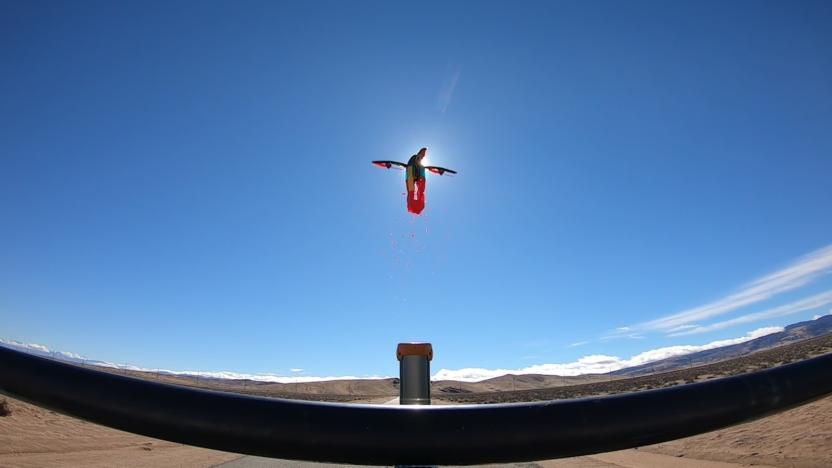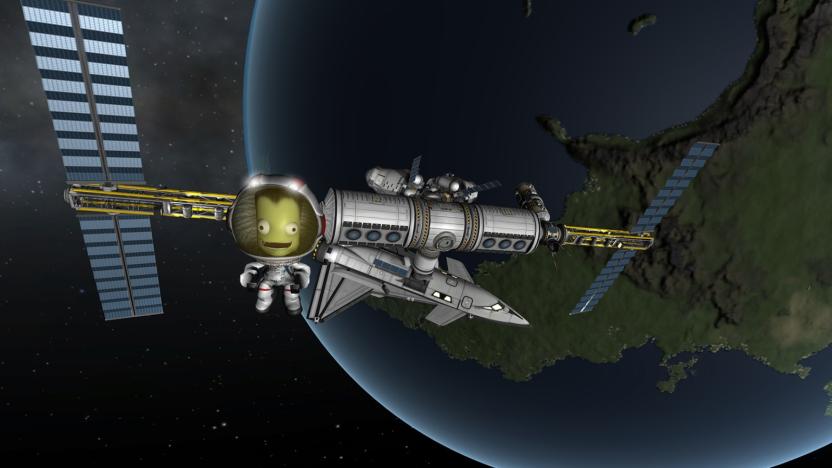space exploration
Latest

‘No Man’s Sky’ update brings sentient robots and freighter-to-freighter combat
There’s already been three ‘No Man’s Sky’ updates this year, but get ready for a fourth. The developer just dropped ‘No Man’s Sky: Echos’ to commemorate the seventh anniversary of everyone’s favorite space sim. The update brings some nifty new gameplay elements, like a race of sentient robots that promise “rich, new story content” and the ability to create your own robot avatar to battle and collect resources.

NASA wants ideas for keeping Moon missions powered in the dark
NASA is crowdsourcing ideas for energy systems that would keep Moon missions powered, even in the dark.

Earth’s first off-world colonies will be built on soil
Elsewhere, however, “regolith is basically just moon dirt or Mars dirt,” says Jennifer Edmundson, a geologist and in-space manufacturing engineer at Jacobs Space Exploration Group, a NASA contractor.

Watch a 'transforming' drone blast out of a cannon
Researchers launched a drone from a pneumatic baseball pitching machine strapped to a truck traveling 50 miles per hour. They hope this ballistic launch method might lead to drones that are better suited for emergency response and space exploration missions.

Scientists discover water vapor on an exoplanet with a rocky core
Water vapor is common in gas giants; Jupiter, Saturn, Uranus and Neptune all have H2O floating around in their atmospheres. But water on a rocky planet is exceedingly rare, making the discovery of water vapor -- and possibly even rain -- on the exoplanet K2-18 b a surprising breakthrough.

‘Kerbal Space Program’ gets an interstellar flight sequel
It's been four years since Kerbal Space Program (KSP) -- the spacecraft building and flight simulation game -- officially launched. While Elon Musk once called the title "awesome" and joked that SpaceX used KSP for testing software, it was due for a refresh. Today, Private Division announced that Kerbal Space Program 2 (KSP2) will arrive in 2020. As part of the reveal, it released cinematic trailer and a (dramatic) developer story.

Watch this little robot learn to walk after taking damage
Robots are getting pretty good at carrying on after taking a knock, but what if they lose a limb? Scientists from the US and France have given a six-legged 'bot the smarts to keep going even if two of its legs are disabled by, say, a Sarah Connor shotgun blast. The team created and then rated a number of simulations for how its robot could keep moving forward despite losing a leg or two. Once that information was programmed into the robot, it was able to rapidly evaluate the options and use the one that worked best in the real world.

Japanese company plans to have working space elevator by 2050
Who does want to go to space? No less, in an elevator. While NASA's been working hard for years trying to find the necessary tools to do just that, other firms are doing the same across different parts of the world. Japanese construction company Obayashi, for instance, is one of those, and today it revealed its plans to have a fully functional space elevator by the year 2050. As Australian Broadcasting Corporation reports, Obayashi says it is working to build a space elevator that can reach 96,000 kilometers (roughly 60,000 miles) into space, capable of transporting people and cargo at a much lower cost than the rockets traditionally launched from Earth. The trip on Obayashi's space elevator is said to take a total of seven days one-way, with the destination being a space station that would be built specifically for this scenario.

Sci-fi sandbox Beyond Sol hopes you'll Greenlight it on Steam
Here's a ray of sandbox sunshine to brighten your morning: Praxia Entertainment has unveiled Beyond Sol, sci-fi pseudo-MMO focused on space exploration, trade, crafting, and piracy. It's even got cities. According to the devs, Beyond Sol is a multiplayer, buccaneering, open world sandbox game, set in the distant future when humanity has developed into a young galactic space-faring civilization. As an independent ship captain, you venture to a newly colonized and virtually lawless outlying system within the rim in order to pursue new opportunities. Once there, anything goes: explore, mine asteroids, salvage derelict ships, plunder merchant vessels, hunt pirates, pilot capital warships, construct an epic orbital city, and make friends with – or rival – other factions and players. Just how MMOsy is it? "The game is designed for 1 to N players (N being dependent on your hardware capabilities)," says Praxia, "meaning you can play single player or you can invite people into your session." The game is angling for approval on Steam Greenlight and intends to hit early access in winter 2015. We've included the game's trailer below.

UK plans to build first spaceport outside the US by 2018
The UK may not have the best history when it comes to space exploration, but that doesn't mean it's not interested in boldly going where only a few people have gone before. According to Sky News, Britain could play host to one of the first spaceports built outside of the US, with a shortlist of eight possible sites expected to be confirmed later this week. As it stands, six of the possible locations are in Scotland, suggesting places like Prestwick, Stornoway and Kinloss, with one in Wales (Llanbedr) and the other in England (Newquay). According to the report, construction could begin as early as 2018, although we're not sure what effect the Scottish Independence referendum would have on the plans. Still, we're loving the fact that any visiting aliens who've hitched a ride on a Virgin Galactic flight will be able to load up on Irn Bru or Teisen radell before heading back to space.

EVE Evolved: Has colonisation been forgotten?
At last year's EVE Online Fanfest, CCP revealed its ambitious plan to take the game where no sandbox MMO has ever gone before: full deep space colonisation. The plan will be delivered over the next five years and will end with the incredibly exciting vision of players building their own stargates and colonising brand-new solar systems that lie off the grid. Rubicon was intended as the first step toward this glorious plan, and its new focus on deployable sandbox structures certainly seemed to be introducing a more player-directed form of colonisation. I've been cautiously optimistic about the whole endeavour so far, but five years is hell of a long time to wait for that vision to come to fruition. Rubicon's Mobile Depot structure was a great first step toward player-run empires on all scales, but none of the recently announced Rubicon 1.1 deployables has continued along the same theme of colonisation and exploration. The Mobile Micro Jump Drive and Mobile Scan Inhibitor structures I looked at last week provide extra tactical options in PvP, and the three new structures revealed this week are all designed to steal money and resources from nullsec corporations. In this week's EVE Evolved, I ask whether the newly revealed Encounter Surveillance System and alternate Siphon Units are a step in the wrong direction. With games like Star Citizen and Elite: Dangerous on the way, CCP may not have five years to deliver the promise of colonisation.

Space explorer Starbound reaches $400,000 in pre-orders
Starbound, a "story within a sandbox" game that has players traversing the universe to explore and complete quests, recently began taking pre-orders. As of this writing, developer Chucklefish hauled in $409,907 in its crowdfunding initiative. While the developer opted to use its official site instead of services such as Kickstarter or Indiegogo to host its tiered funding campaign, it still set stretch goals for the project. A new "novakid" race will be included in the game should pre-orders reach $500,000.The game promises an endless number of procedurally-generated planets that encourage exploration from players. Starbound's site notes that much like a point-and-click adventure game, players can examine and catalog every item on the varying planets. Additionally, Starbound will feature cooperative and competitive multiplayer options.Chucklefish was one of ten developers that earned a free Ouya dev kit in December 2012, though the game's site notes that Starbound only supports Windows, Mac and Linux at this time. Backers will receive a Steam key for the game when it launches sometime in 2013.[Thanks to everyone who sent this in!] %Gallery-185621%

Visualized: Space Shuttle Atlantis makes its final journey, arrives at new home (video)
On Friday, Space Shuttle Atlantis made its final voyage, marking the last time an orbiter in America's shuttle program would be on the move. We were on-hand during the occasion and followed Atlantis as it slowly trekked to its destination, a 90,000 square-foot exhibit building at Kennedy Space Center's Visitor Complex. To live out the event vicariously, check out the photos below or hit the jump for the video.

9-gigapixel image of the Milky Way reminds us just how small we truly are
They say a picture is worth a thousand words, but this just leaves us speechless. Pictured above is a compressed 108,500 x 81,500 pixel image of 84 million stars across central parts of the Milky Way. Taken by the VISTA survey telescope at the ESO's Paranal Observatory in Chile, this 9-gigapixel photo is the result of thousands of individual images being meshed together. If it were printed out at the average resolution of a standard book it would measure a mind-boggling 9 x 7 meters. Using three separate infrared filters, VISTA is able to see through dust fields that normally obscure the view of an optical telescope. By studying this monumental image, astronomers hope to gain a better understanding of how galaxies form and evolve. If you'd like to take a look at this galactic work of art in its entirety, you can do so by visiting the source link below. (Image credit: ESO/VVV Consortium)

NASA and IHMC building X1 exoskeleton to give us a lift, keep us fit in space and on Earth
It's hard to deny the appeal of a space-bound robot like NASA's Robonaut 2, fears of subversion notwithstanding. The space agency and Florida's Institute for Human and Machine Cognition know it, and they want to put that technology into an exoskeleton with a nobler purpose than performing chores on space stations. The in-development X1 (not yet pictured) adapts the Robonaut's skills to a body-hugging frame with 10 points of movement that might give humans an assist when they need it the most. In space, the X1 could automate and add challenge to exercise for astronauts in low gravity, or provide the extra muscle for that fabled day we return to manned surface exploration. NASA envisions its exoskeleton having more grounded uses as well, such as rehabilitation for leg injuries or walking for those who never had the chance. Although we're not expecting a rapid turnaround knowing NASA's lengthy schedules, we might see the X1 in use sooner than most such products in the wake of a purposefully quick development cycle -- and, no doubt, a few interested customers here on Earth.

Space Shuttle Atlantis hands-on: a look inside (video)
Space Shuttles Discovery, Endeavour and Enterprise have all left Kennedy Space Center for new homes, but Atlantis? She's staying. Come November 2nd, the orbiter will be wheeled out to a 65,000-square-foot exhibit, which is still being constructed at KSC's visitor complex. Though the craft's cargo bay doors will be open and its remote manipulator arm extended when its displayed, visitors won't be able to climb aboard it -- or any of the other shuttles, for that matter. However, we got the chance to visit Bay 2 of the Orbiter Processing Facility, step inside Atlantis and give it the hands-on treatment. Look out below for the gallery or hit the jump for the full video tour.

NASA's Curiosity rover checks in on Foursquare, gives Mars its first mayor
Yes, seriously. NASA announced on Wednesday that its Curiosity rover had "checked in" on Mars via Foursquare. Marking the first check in from another world, the robotic rover will utilize the location-minded social network to share updates and pictures while visiting the Red Planet. While Curiosity will continue to explore the possibilities of Mars being able to sustain life, it would appear that the fourth planet from the sun just got a brand new mayor. Something tells us the universe's rarest badge is about to be bestowed.

NASA's Curiosity rover finds ancient streambed on Mars, evidence of 'vigorous' water flow
Curiosity may have spent a while limbering up for the mission ahead, but now it's found evidence of an ancient streambed on Mars that once had "vigorous" water flow. Photos of two rock outcroppings taken by the rover's mast camera between the north rim of Gale Crater and the foot of Mount Sharp reveal gravel embedded into a layer of conglomerate rock. The shape of the small stones indicate to NASA JPL scientists that they were previously moved, and their size (think from grains of sand to golf balls) are a telltale sign that water did the work instead of wind. Evidence of H2O on Mars has been spotted before, but this is the first direct look at the composition of riverbeds NASA has observed from above. According to Curiosity science co-investigator William Dietrich, it's estimated that water flowed at the site anywhere from thousands to millions of years ago, moved at a clip of roughly 3 feet per second and was somewhere between ankle and hip deep. "A long-flowing stream can be a habitable environment," Mars Science Laboratory Project Scientist John Grotzinger said. "It is not our top choice as an environment for preservation of organics, though. We're still going to Mount Sharp, but this is insurance that we have already found our first potentially habitable environment."

Space Shuttle Endeavour hitching a ride atop a 747 to its new home on September 17
Space Shuttles Discovery and Enterprise have already settled into their new homes, and now Endeavour is scheduled to depart for its future abode at the California Science Center on September 17th. Taking to the skies atop a modified Boeing 747, the shuttle will make pit stops in Texas and at Edwards Air Force Base in the Golden State before touching down at Los Angeles International Airport on the 20th. During the journey out west, the Shuttle Carrier Aircraft will buzz certain cities and NASA sites along its flight path at roughly 1,500 feet in altitude. After its voyage, Endeavor will head to the science center on October 13th, but won't be on display until the end of the month. Yearning to catch a glimpse of the historic vehicle before it reaches its final resting place? Head past the jump for its flight schedule and flyover details.

NASA's Voyager 1 marks 35th anniversary of its launch, gets photo retrospective in tribute
It's hard to believe at times that the Voyager 1 probe is older than many of us reading this article, but it's true. The official first part of NASA's Voyager program launched just over 35 years ago on September 5th, 1977, carrying not just cameras and sensors to capture the trip but the famous Golden Record documenting humanity for any curious aliens. To mark the occasion, Wired has gathered together one heck of a photo album that covers both Voyager 1's trip as well as that of Voyager 2, which technically launched earlier (August 20th the same year) but took a more roundabout route through the solar system. The gallery reminds us of the amazing scenery beyond Mars and puts our tiny blue ball of a planet in perspective; Earth was just a speck at best when photographed late into Voyager 2's journey. Perhaps the best news surrounding the milestone is simply that both Voyager probes are still running. At 11 billion miles from the Sun, Voyager 1 may be on the cusp of interstellar space and easily represents the most distant human object ever made, not to mention a record-setter for signal transmissions. There's even a chance we'll still be hearing back from the probe for its 50th anniversary -- its power could keep it chatting up to roughly 2025.












